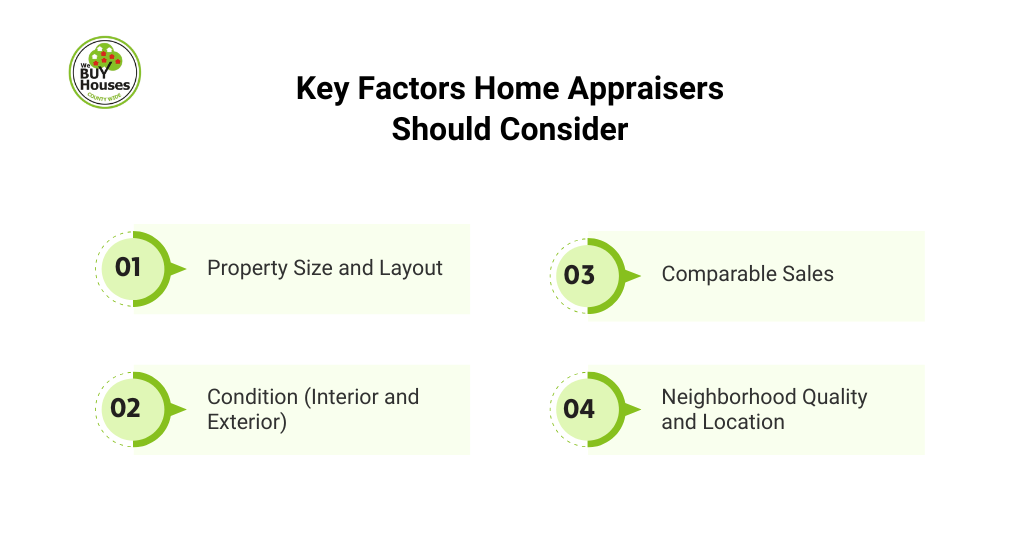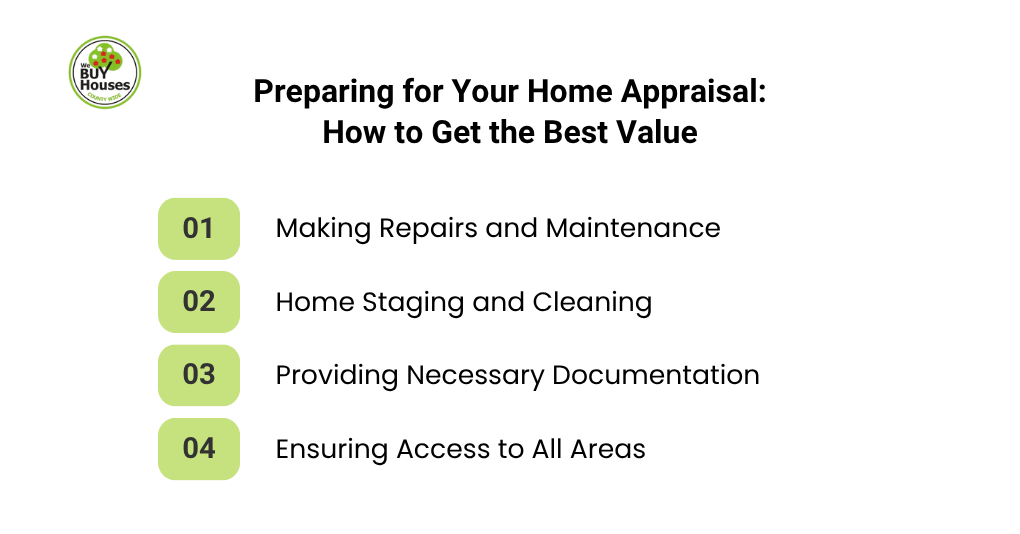When planning to sell or refinance, the way a home is prepared can significantly influence its appraised value. A thoughtfully structured home appraisal checklist helps homeowners focus on the essentials: completing repairs, organizing documentation, and presenting the property in its best condition before the appraiser’s visit. Taking these steps early often makes the difference between a satisfactory valuation and an exceptional one.
During the appraisal process, a certified appraiser examines the home’s size, layout, condition, comparable sales, and neighborhood quality to determine its market value. Understanding these factors allows homeowners to direct their efforts toward improvements that have the greatest impact.
By handling small fixes, enhancing curb appeal, and maintaining clear records of upgrades, sellers show that their home has been properly maintained. This preparation builds buyer confidence, supports a fair valuation, and often leads to a faster, more rewarding sale.

What is a Home Appraisal and Why Is It Important?
A home appraisal is a professional and unbiased evaluation conducted by a licensed appraiser. It determines a property’s market value by examining its size, layout, condition, recent comparable sales, and neighborhood quality. This process provides a realistic view of what a home is worth and supports fair, informed decisions in real estate transactions. Understanding why a home appraisal matters helps homeowners, buyers, and lenders make smarter financial decisions based on accurate property data.
Key reasons a Home Appraisal is important:
- Ensures buyers pay a fair and accurate price for the property.
- Helps sellers set a competitive and data-backed listing price.
- Determines homeowner equity during refinancing or loan applications.
- Builds lender confidence for mortgage approval.
- Prevents pricing disputes and contract renegotiations.
- Protects both parties from overvaluation or undervaluation risks.
- Provides an official record of value for tax or insurance purposes.
- Reflects current market trends and neighborhood demand.
Overview of the Home Appraisal Process
The home appraisal process is a detailed evaluation that combines professional inspection with market research to determine a property’s true market value. It ensures that the price of a home reflects its actual condition, features, and standing within current real estate trends.
Main steps in the home appraisal process are:
- Ordering the Appraisal: Usually arranged by the lender or homeowner once a sale, purchase, or refinance is underway.
- On-Site Inspection: The appraiser visits the property to examine its structure, layout, size, and overall condition.
- Market Comparison: Recent sales of similar homes, called “comps,” are analyzed to identify fair value within the neighborhood.
- Valuation Report: The appraiser compiles findings and supporting data into a formal report that states the property’s estimated worth.
This systematic approach provides an objective foundation for real estate decisions, ensuring fairness for both buyers and sellers.
What to Expect During an Appraisal?
A home appraisal involves an appraiser visiting the property to inspect its condition, measure its size, and gather details needed to determine its market value. The process is typically brief but thorough, focusing on both the home’s physical features and how it compares to similar properties in the area.
Here is what happens during the appraisal:
- Initial Walkthrough: The appraiser arrives, explains the process, and begins with an exterior review.
- Exterior Evaluation: Key elements like the roof, foundation, siding, and landscaping are examined for condition and quality.
- Interior Inspection: The appraiser checks room measurements, finishes, systems, and any upgrades or maintenance issues.
- Follow-Up Questions: Homeowners may be asked about renovations or improvements that could influence value.
Key Factors Home Appraisers Should Consider
Appraisers determine a home’s value by focusing on key factors such as size, layout, condition, comparable sales, and location. Larger, well-designed homes usually appraise higher, while poor maintenance can reduce value. Recent sales of similar properties and the overall quality of the neighborhood also play major roles in setting a fair market estimate.

Property Size and Layout
A property’s size and layout have a direct impact on its market value because they determine how livable, functional, and appealing the home feels to buyers. Appraisers evaluate not just total square footage but also how efficiently the space is designed and used. A well-planned layout can increase value even in smaller homes, while wasted or awkward space can lower it.
Key points appraisers consider are:
- Square Footage: Larger homes usually command higher appraisals when the space is practical and well-finished.
- Room Count: Additional bedrooms, bathrooms, or living areas typically raise the property’s value.
- Functionality: Open floor plans and smart space flow improve usability and buyer appeal.
- Finished Additions: Upgraded basements, attics, or extensions add measurable value to the total living area.
A balanced layout with purposeful design often enhances a property’s overall desirability and appraisal score.
Condition (Interior and Exterior)
A home’s interior and exterior condition greatly influence its appraised value because they reflect how well the property has been maintained over time. Appraisers assess both visual appeal and structural integrity, noting any signs of neglect, wear, or recent upgrades that affect market perception.
Here is what appraisers evaluate:
- Exterior Condition: The roof, foundation, siding, windows, paint, and landscaping are checked for visible damage or maintenance issues.
- Interior Condition: Walls, flooring, fixtures, and finishes are examined for quality, cleanliness, and upkeep.
- Major Systems: Plumbing, electrical, and HVAC systems are reviewed for functionality and age.
- Recent Improvements: Updated kitchens, bathrooms, or energy-efficient upgrades can significantly raise value.
Well-maintained homes with functional systems and fresh finishes signal lower future maintenance costs, often leading to higher appraisals.
Comparable Sales
Appraisers rely on comparable sales, or “comps,” to determine a property’s fair market value by comparing it to similar recently sold homes nearby. These comparisons help ensure the appraisal reflects real, current market conditions.
What appraisers look for in comps are:
- Similarity of Homes: Properties with comparable size, age, style, and condition are selected for accurate comparison.
- Recent Sale Data: Comps usually come from sales within the last three to six months to reflect current market conditions.
- Adjustments for Differences: Appraisers adjust values for variations such as larger lots, remodeled interiors, or added features.
- Neighborhood Impact: Homes in the same or nearby neighborhoods carry the most weight since location directly affects value.
Understanding comps helps homeowners see how their property stacks up against local sales and what influences its appraised price.
Neighborhood Quality and Location
A home’s neighborhood quality and location play a major role in how appraisers determine its value. Even a well-maintained property may appraise lower if it’s in an area with weak demand, while homes in desirable neighborhoods often receive higher valuations.
Key location factors appraisers consider are as follows:
- Proximity to Amenities: Access to schools, parks, shopping, and public transport increases appeal.
- Safety and Crime Rates: Safer neighborhoods typically command higher market values.
- Market Demand: Areas with consistent buyer interest or limited inventory can boost appraisal value.
- Overall Appearance: Clean streets, maintained homes, and good curb appeal within the community add to perceived worth.
In short, location sets the foundation for value, influencing how buyers and the market view a property beyond its physical features.
Preparing for Your Home Appraisal: How to Get the Best Value
Proper preparation before a home appraisal can make a measurable difference in the final valuation, often determining whether a home meets, exceeds, or falls below market expectations. Homeowners should focus on completing repairs, cleaning and staging, organizing documentation, and ensuring full access to every part of the home. A well-presented property shows care and maintenance, helping the appraiser form a positive impression that can lead to a higher valuation.

Making Repairs and Maintenance
Making repairs and performing maintenance before an appraisal is one of the most effective ways to protect your home’s value. Even small fixes can prevent deductions and show that the property has been well cared for, which positively influences the appraiser’s assessment.
Repairs and maintenance to prioritize include:
- Fix Minor Issues: Patch wall cracks, replace broken tiles, and repair leaky faucets or doors that do not close properly.
- Inspect Major Systems: Ensure plumbing, electrical, and HVAC systems are functioning safely and efficiently.
- Address Structural Concerns: Repair any foundation cracks, roof leaks, or water damage that could signal bigger problems.
- Update Worn Elements: Replace damaged flooring, chipped paint, or outdated fixtures that impact visual appeal.
Home Staging and Cleaning
Home staging and cleaning are powerful ways to influence how an appraiser perceives your property’s care, condition, and livability. A clean, organized, and visually appealing home signals pride of ownership and can subtly enhance the appraiser’s overall impression. Even small touches, like bright lighting, fresh scents, and balanced décor, help present the space at its best.
Effective staging and cleaning methods are:
- Declutter and Organize: Keep spaces open and tidy to highlight flow and functionality.
- Deep Clean Thoroughly: Clean floors, windows, and surfaces to show consistent upkeep.
- Use Neutral Décor: Light colors and simple arrangements help rooms appear larger and brighter.
- Refresh the Exterior: Mow the lawn, trim plants, and clean entryways for strong curb appeal.
Providing Necessary Documentation
Providing documentation during a home appraisal helps the appraiser verify improvements, maintenance, and property details that may not be immediately visible. Organized records show transparency and support a more accurate, data-backed valuation of your home.
Steps for effective staging and cleaning:
- Receipts for Upgrades: Include invoices for renovations, new appliances, or major repairs like roofing or HVAC replacement.
- Maintenance Records: Provide evidence of regular servicing, inspections, or pest control.
- Property Disclosures: Share information about the home’s age, systems, and any recent updates or additions.
- Survey or Inspection Reports: Offer prior inspection results or property surveys if available.
Ensuring Access to All Areas
Ensuring the appraiser has full access to every part of your property is essential for a complete and accurate evaluation. Restricted or cluttered spaces can delay the process or cause the appraiser to miss key features that contribute to your home’s value.
Areas to keep accessible are:
- Basements and Attics: Clear pathways so the appraiser can inspect finished or unfinished spaces.
- Garages and Outbuildings: Unlock and organize these areas to allow easy viewing of their condition and usability.
- Utility and Storage Areas: Make sure electrical panels, plumbing, and HVAC systems are visible and reachable.
- Exterior Spaces: Provide access to patios, decks, and yards for a full assessment of the property.
What to Do if the Appraisal Comes in Low?
If a home appraisal comes in lower than expected, homeowners should first review the report for errors, then consider requesting a second appraisal or negotiating with the buyer. Common steps include verifying comparable sales, disputing inaccuracies with supporting data, and working with the lender to reassess value. Taking quick, informed action can often help correct undervaluations or reach a fair agreement that keeps the sale moving forward.
Reviewing the Appraisal Report
When reviewing an appraisal report, homeowners should check for accuracy and completeness to ensure the property was evaluated fairly. Small errors or missing details can affect the final value.
Key areas to review:
- Property Details: Confirm that the appraiser correctly listed square footage, room count, and features.
- Comparable Sales: Check that the chosen comps are similar in size, condition, and location.
- Condition Notes: Make sure recent repairs or upgrades were acknowledged.
- Data Accuracy: Look for any factual mistakes, such as outdated sales data or incorrect neighborhood information.
Identifying and addressing these issues early allows homeowners to request corrections or provide additional information that supports a more accurate valuation.
Requesting a Second Appraisal
Homeowners can request a second appraisal if they believe the initial one was inaccurate or incomplete. This step is useful when clear errors, missing data, or overlooked improvements affected the first valuation.
When to request a second appraisal:
- Errors in the First Report: Incorrect property details, outdated comps, or missed upgrades.
- New Supporting Evidence: Availability of stronger comparable sales or updated market data.
- Lender Approval: The homeowner must receive permission from the lender to order a new appraisal.
- Documentation Ready: All records of improvements, photos, or reports should be provided for review.
A second appraisal offers a fair opportunity to correct mistakes and achieve a valuation that more accurately reflects the home’s true market worth.
Negotiating with Buyers
When a home appraisal comes in below the agreed sale price, negotiating with buyers becomes essential to keep the deal moving forward. Open communication and flexibility help both sides reach a fair solution.
Ways to handle a low appraisal with buyers:
- Discuss the Report: Review the findings together and identify areas that may justify a higher value.
- Renegotiate the Price: Adjust the sale price to align with the appraised amount if both parties agree.
- Offer Seller Concessions: Cover some closing costs to make the deal more appealing without lowering the price.
- Provide Additional Evidence: Share new comparable sales or documentation that supports a value reconsideration.
By remaining cooperative and solution-focused, sellers can preserve buyer interest while achieving a fair outcome for both parties.
Disputing the Appraisal
If you believe your home appraisal is too low, you can dispute it by providing clear evidence that supports a higher value. The goal is to correct mistakes or overlooked details that may have affected the final report.
How to dispute an appraisal:
- Check for Errors: Review property details and comparable sales for inaccuracies.
- Provide Proof: Submit updated comps, photos, or receipts for recent improvements.
- Request Reconsideration: Send your findings to the lender for review.
Submitting accurate, well-supported information gives the lender reason to reevaluate and may help raise the appraised value.
Increasing Your Home’s Appraisal Value: Tips for Sellers
To increase your home’s appraisal value, focus on small but meaningful upgrades that enhance both condition and presentation. Simple improvements like repainting, updating fixtures, refreshing landscaping, and keeping detailed records of repairs can make the property appear well-maintained and desirable. A clean, updated, and well-documented home often leaves a strong impression, helping the appraiser justify a higher market value.
Renovations and Home Improvements
Smart renovations and home improvements help demonstrate that a property is well-maintained and aligned with current market expectations. Appraisers take note of updates that improve functionality, energy efficiency, and overall design quality.
High-Impact Improvements:
- Kitchen Updates: Modern countertops, cabinets, and appliances instantly add appeal.
- Bathroom Upgrades: New fixtures, lighting, and tile can make the space feel refreshed.
- Energy Efficiency: Features like upgraded windows or HVAC systems enhance long-term value.
- New Flooring: Replacing worn materials with durable, attractive options improves presentation.
Even modest upgrades can create a strong impression, helping the appraiser see lasting value and care in the property.
Enhancing Curb Appeal
Curb appeal strongly influences an appraiser’s first impression and can set the tone for the entire evaluation. A clean, well-kept exterior signals pride of ownership and suggests the home has been properly maintained.
Ways to Enhance Curb Appeal:
- Landscaping: Keep the lawn trimmed, add fresh mulch, and plant seasonal flowers.
- Exterior Cleaning: Power wash siding, walkways, and driveways for a fresh appearance.
- Entryway Upgrades: Repaint the front door, replace old hardware, and add clear house numbers.
- Repairs and Lighting: Fix cracks, update outdoor lighting, and ensure everything looks inviting.
These simple updates make a strong visual impact, helping the appraiser see your property as well cared for and valuable.
Staging Your Home for Appraisal
Preparing your home’s presentation before the appraiser arrives can make a meaningful difference in how its value is perceived. Staging your home for appraisal helps emphasize space, light, and functionality, qualities that appraisers notice when forming their overall impression.
Simple staging tips:
- Declutter and Simplify: Keep surfaces clear and rooms open to highlight flow and size.
- Use Neutral Décor: Soft, neutral tones make spaces feel bright and inviting.
- Maximize Lighting: Let in natural light and ensure fixtures work properly.
- Showcase Key Features: Draw attention to upgrades like fireplaces, built-ins, or modern finishes.
A neat, well-presented home signals care and maintenance, helping the appraiser see its full market value.
How to Present Your Home to the Appraiser?
You can present your home effectively to the appraiser by making it clean, well-lit, and fully accessible, which helps them assess its features without obstacles. A neat, organized environment showcases care and maintenance, allowing the appraiser to focus on value-driving details like upgrades, layout, and condition.
Tips for Presenting Your Home Effectively:
- Prepare the Property: Clean thoroughly, open blinds, and remove clutter to enhance visibility.
- Ensure Full Access: Unlock all rooms, attics, basements, and exterior areas.
- Provide Key Information: Share records of renovations, repairs, and system updates.
- Be Professional: Greet the appraiser, answer questions politely, and let them work independently.
By making your home easy to evaluate and presenting it confidently, you help the appraiser form a clear, positive impression that supports its true value.
Common Home Appraisal Myths and Misunderstandings
Many homeowners misunderstand how home appraisals work, believing things like pricing or personal opinions can affect the outcome. In truth, appraisals are objective evaluations based on condition, data, and market trends. Understanding this helps sellers focus on proper preparation and trust the process as a fair, unbiased assessment of value.
“The Appraised Value is Always the Same as the Sale Price”
The appraised value of a home is not always the same as the sale price because each is determined differently. The appraisal reflects an objective estimate of market value based on comparable sales, property condition, and location, while the sale price depends on negotiations, demand, and timing. In some cases, a strong market or motivated buyer may push the sale price above the appraised value, while in slower markets, it may fall below.
“Appraisers Only Consider the Home’s Condition”
Appraisers consider much more than just a home’s condition when determining its value. While maintenance and appearance matter, they also evaluate location, size, layout, comparable sales, and market trends. For example, a well-kept home in a less desirable area may appraise lower than a dated property in a high-demand neighborhood. Each factor works together to create a balanced and fair valuation of the property.
“You Can Influence the Appraisal Value”
Homeowners cannot directly influence the appraised value, as appraisers are required to remain independent and objective. Their assessment is based solely on measurable factors like comparable sales, property condition, and market data. While you cannot sway the outcome through persuasion, you can still impact the process positively by keeping your home clean, well-maintained, and providing documentation of recent improvements. These steps help ensure the appraiser has accurate information to determine fair value.
Frequently Asked Questions
How long does an appraisal take?
A standard home appraisal usually takes between 30 minutes and two hours, depending on the size and complexity of the property. Larger homes or those with unique layouts may require more time. After the on-site visit, the appraiser typically spends several days gathering comparable sales data, analyzing market trends, and completing the official report, so the full process often takes about three to seven days from start to finish.
Can I be present during the appraisal?
Yes, homeowners can be present during a home appraisal, but it is not required. Being there can be helpful, as you can provide access to all areas and share information about recent upgrades or repairs. However, it’s best to give the appraiser space to work independently. Staying available for questions without interrupting allows for a smooth process and ensures the appraiser can focus on an accurate and impartial evaluation.
How much does an appraisal cost?
A home appraisal typically costs between $300 and $600, though the price can vary based on the property’s size, location, and complexity. Larger homes or properties in rural areas often cost more because they require additional time and research. Some lenders include the appraisal fee in closing costs, while others require it to be paid up front. Regardless of payment method, the fee is non-refundable since the appraisal is an independent professional service.
What happens if I disagree with the appraisal?
If you disagree with a home appraisal, you can request a review, provide additional evidence, or ask for a second opinion. Start by checking the report for mistakes, such as incorrect details or missing upgrades, and gather proof like recent comparable sales or receipts for improvements. Submitting this information to your lender through a reconsideration of value can help ensure the appraisal reflects your home’s true market worth.
